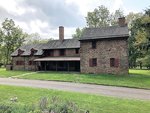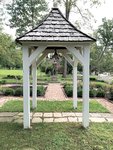

Canceled last year because of Covid restrictions, severe weather was the reason for the recurring cancellation of events this year.
Scheduled to appear Aug. 28 along with the annual Revolutionary War Reenactment performance of the First Crossing and Donegal Regiments at Moland House were the Penns Woods Puppet Theater, Colonial cooking, lacemaker, brewer, gunsmith, folk artist, and woodworkers.
Unable to reschedule, they will wait eagerly in the wings for next year.
In the past it proved difficult at best to reschedule the varied artisans and volunteer, according to JoAnne Mullen, reenactment chair. Moland House is staffed strictly on a volunteer basis. Many are not available to convene at another time.
“Each year at the time of the Neshaminy encampment a reenactment celebrates the events of 1777,” said Dave Mullen, former president. “Over the past 15 years the event has drawn 300 to 600 attendees per seasonal event.”
Moland House, Washington’s Headquarters Farm, is a stone farmhouse built around 1750, by John Moland from London, a prominent Philadelphia and Bucks County lawyer. The house served as headquarters for Gen. George Washington during the American Revolutionary War from Aug. 10 to 23, 1777 on his way to the Battle of Brandywine. The encampment stretched along Old York Road, and Bristol Road from Mearns Road to Meetinghouse Road.
In the early evening of Aug. 10, 1777, 11,000 Continental Army and militia soldiers were marching up York Road on their way to Coryell’s Ferry (New Hope), intending to camp four miles beyond the Delaware River in New Jersey. Gen. George Washington received a dispatch from John Hancock, president of the Second Continental Congress, informing him that the 260-vessel British fleet, hauling 17,000 British Army and Hessian troops led by Gen. William Howe, was 50 miles south of the Delaware Capes (May and Henlopen) on Aug. 7.
Unsure and wary of Howe’s intentions, Washington immediately halted his force to encamp around the bridge over the Little Neshaminy Creek in Warwick Township. He selected the substantial stone dwelling of Widow Moland as his headquarters on the farm north of the bridge. Gen. Washington held a Council of War with his four major generals and six brigadier generals in the Moland House.
Join our readers whose generous donations are making it possible for you to read our news coverage. Help keep local journalism alive and our community strong. Donate today.